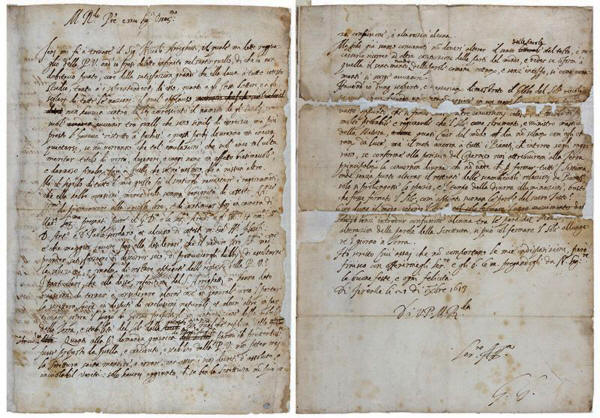|

by Alison Abbott
21 September
2018
from
Nature Website
Spanish version

The original letter in which Galileo
argued
against the doctrine of the Roman Catholic Church
has
been rediscovered in London.
Credit:
The Royal Society
Document shows
that the
astronomer toned down the claims
that triggered
science history's
most infamous
battle...
...then lied
about
It had been hiding in plain sight.
The original letter -
long thought lost - in which
Galileo Galilei first set down
his arguments against the church's doctrine that 'the Sun orbits
the Earth' has been discovered in a misdated library catalogue
in London.
Its unearthing and
analysis expose critical new details about the saga that led to the
astronomer's condemnation for 'heresy' in 1633.
The seven-page letter, written to a friend on 21 December 1613 and
signed "G.G.", provides the strongest evidence yet that, at the
start of his battle with the religious authorities, Galileo actively
engaged in damage control and tried to spread a toned-down version
of his claims.
Many copies of the letter were made, and two differing versions
exist:
But because the original
letter was assumed to be lost, it wasn't clear whether incensed
clergymen had doctored the letter to strengthen their case for
heresy - something Galileo complained about to friends - or whether
Galileo wrote the strong version, then decided to soften his own
words.
Galileo did the editing, it seems...
The newly unearthed
letter is dotted with scorings-out and amendments - and handwriting
analysis suggests that Galileo wrote it. He shared a copy of this
softened version with a friend, claiming it was his original, and
urged him to send it to
the Vatican.
The letter has been in
the Royal Society's possession for
at least 250 years, but escaped the notice of historians.
It was rediscovered in
the library there by Salvatore Ricciardo, a postdoctoral
science historian at the University of Bergamo in Italy, who visited
on 2 August for a different purpose, and then browsed the online
catalogue.
"I thought, 'I can't
believe that I have discovered the letter that virtually all
Galileo scholars thought to be hopelessly lost'," says Ricciardo.
"It seemed even more
incredible because the letter was not in an obscure library, but
in the Royal Society library."
Ricciardo, together with
his supervisor Franco Giudice at the University of Bergamo
and science historian Michele Camerota of the University of
Cagliari, describe the letter's details and implications in an
article in press at the Royal Society journal
Notes and Records.
Some science historians
declined to comment on the finding before they had scrutinized the
article.
But Allan Chapman,
a science historian at the University of Oxford, UK, and president
of the Society for the History of Astronomy, says
"it's so valuable -
it will allow new insights into this critical period".

The first and last page of Galileo's letter
to
his friend Benedetto Castelli.
The
last page shows his signature, "G. G.".
Credit:
The Royal Society
Mixed messages
Galileo wrote the 1613 letter to
Benedetto Castelli, a
mathematician at the University of Pisa in Italy. In it, Galileo set
out for the first time his arguments that scientific research should
be free from theological doctrine (see 'The
Galileo Affair').
He argued that the scant references in the Bible to astronomical
events should not be taken literally, because scribes had simplified
these descriptions so that they could be understood by common
people. Religious authorities who argued otherwise, he wrote, didn't
have the competence to judge.
Most crucially, he
reasoned that the heliocentric model of Earth orbiting the Sun,
proposed by Polish astronomer
Nicolaus Copernicus 70 years
earlier, is not actually incompatible with the Bible.
Galileo, who by then was living in Florence, wrote thousands of
letters, many of which are scientific treatises. Copies of the most
significant were immediately made by different readers and widely
circulated.
His letter to Castelli caused a storm.
Of the two versions known to survive, one is now held in the Vatican
Secret Archives. This version was sent to the Inquisition in Rome on
7 February 1615, by a Dominican friar named
Niccol˛ Lorini.
Historians know that
Castelli then returned Galileo's 1613 letter to him, and that on 16
February 1615 Galileo wrote to his friend
Pietro Dini, a cleric in Rome,
suggesting that the version Lorini had sent to the Inquisition might
have been doctored.
Galileo enclosed with
that letter a less inflammatory version of the document, which he
said was the correct one, and asked Dini to pass it on to Vatican
theologians.
His letter to Dini complains of the,
"wickedness and
ignorance" of his enemies, and lays out his concern that the
Inquisition "may be in part deceived by this fraud which is
going around under the cloak of zeal and charity".
Painting of
Galileo explaining his theories

Galileo's celestial ideas
were
deemed heretical
and he
lived his final nine years
under
house arrest.
Credit:
DeAgostini/Getty
At least a dozen copies of the version Galileo sent to Dini are now
held in different collections.
The existence of the two versions created confusion among scholars
over which corresponded to Galileo's original.
Beneath its scratchings-out and amendments, the signed copy
discovered by Ricciardo shows Galileo's original wording - and it is
the same as in the Lorini copy.
The changes are telling.
In one case, Galileo
referred to certain propositions in the Bible as,
"false if one goes by
the literal meaning of the words".
He crossed through the
word "false", and replaced it with "look different from the truth".
In another section, he
changed his reference to the Scriptures,
"concealing" its most
basic dogmas, to the weaker "veiling".
This suggests that
Galileo moderated his own text, says Giudice.
To be certain that the
letter really was written in Galileo's hand, the three researchers
compared individual words in it with similar words in other works
written by Galileo around the same time.
Timeline - The Galileo affair
-
1543 - Polish
astronomer Nicolaus Copernicus publishes his book
On the Revolutions of the Heavenly
Spheres, which proposes that the planets
orbit the Sun.
-
1600 -
The Inquisition in Rome
convicts Dominican friar and mathematician
Giordano Bruno of
heresy on multiple counts, including supporting and
extending the Copernican model. Bruno is burnt at the stake.
-
1610 - Galileo
publishes his book
The Starry Messenger (Sidereus
nuncius), describing discoveries made with his newly built
telescope that provide evidence for the Copernican model.
-
1613 - Galileo
writes a letter to his friend Benedetto Castelli, arguing
against the doctrine of the Roman Catholic Church in matters
of astronomy. Copies of this letter are circulated.
-
1615 - Dominican
friar Niccol˛ Lorini forwards a copy of the letter to the
inquisition in Rome. Galileo asks a friend to forward what
he claims to be a copy of his original letter to Rome; this
version is less inflammatory than Lorini's.
-
1616 - Galileo is
warned to abandon his support of the Copernican model. Books
supporting the Copernican model are banned. On the
Revolutions of the Heavenly Spheres is withdrawn from
circulation pending correction to clarify that it is only a
theory.
-
1632 - Galileo
publishes
Dialogue Concerning the Two Chief
World Systems, in which he lays out the
various evidence for and against the Church's Ptolemaic
model of the Solar System, and the Copernican model. The
Inquisition summons Galileo to Rome to stand trial.
-
1633 - Galileo is
convicted on "vehement suspicion of heresy" and the book is
banned. He is issued with a prison sentence, later commuted
to house arrest, under which lived the last nine years of
his life.
Chance
discovery
Ricciardo uncovered the document when he was spending a month this
summer touring British libraries to study any handwritten comments
that readers might have left on Galileo's printed works.
When his one day at the
Royal Society was finished, he idly flicked through the online
catalogue looking for anything to do with Castelli, whose writings
he had recently finished editing.
One entry jumped out at him:
a letter that Galileo
wrote to Castelli.
According to the
catalogue, it was dated 21 October 1613.
When Ricciardo examined
it, his heart leapt. It appeared to include Galileo's own signature,
"G.G."; was actually dated 21 December 1613, and contained many
crossings out.
He immediately
realized the letter's potential importance and asked for permission
to photograph all seven pages.
"Strange as it might
seem, it has gone unnoticed for centuries, as if it were
transparent," says Giudice.
The misdating might be
one reason that the letter has been overlooked by Galileo scholars,
says Giudice.
The letter was included
in an 1840 Royal Society catalogue - but was also misdated
there, as 21 December 1618. Another reason might be that the Royal
Society is not the go-to place in the United Kingdom for this type
of historical document, whose more natural home would have been the
British Library.
The historians are now trying to trace how long the letter has been
in the Royal Society library, and how it arrived there.
They know that it has
been there since at least the mid-eighteenth century, and they have
found hints in old catalogues that it might even have been there a
century or more earlier.
The researchers speculate
that it might have arrived at the society thanks to close
connections between the Royal Society and the
Academy of Experiments in
Florence, which was founded in 1657 by Galileo's students but
fizzled out within a decade or so.
For now, the researchers are stunned by their find.
"Galileo's letter to
Castelli is one of the first secular manifestos about the
freedom of science - it's the first time in my life I have been
involved in such a thrilling discovery," says Giudice.
|




